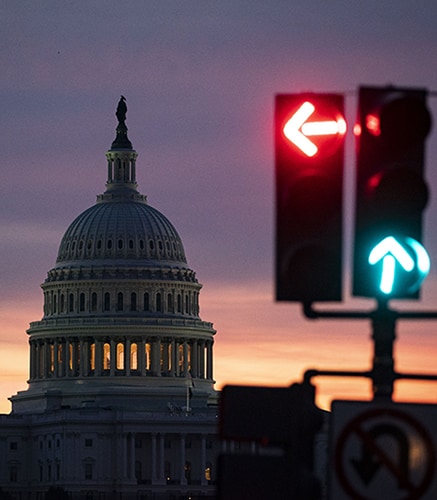Tax News You Can Use | For Professional Advisors

Jane G. Ditelberg
Director of Tax Planning, The Northern Trust Institute
On July 18, Treasury issued final regulations under section 401 of the Internal Revenue Code, updating them to address the statutory changes made by SECURE in 2019 and SECURE 2.0 in 2022 to the rules governing IRAs and defined contribution retirement plans, like 401(k), 403(b) or profit-sharing plans (collectively “retirement accounts”). Many of the provisions of the proposed regulations issued in February 2022 were made final, but there are some new provisions and clarifications that respond to statutory changes from SECURE 2.0 as well as public comments received by the IRS during the rulemaking process. Several Northern Trust partners contributed to the public comments submitted by the American College of Trust and Estate Counsel and the American Bankers’ Association, and we are pleased to report that at least a few of those comments were incorporated into what the IRS ultimately issued.
RMDs from Inherited Retirement Accounts
For individual taxpayers, the most significant news is the answer to a question that even the IRS has seemed unsure about - what are the withdrawal requirements for the beneficiary of an inherited retirement account from an account owner who died after reaching his or her required beginning date for distributions (April 1 of the year after reaching age 72-75, depending on year of birth)? Is the only obligation of the beneficiary to withdraw all the assets by the end of the tenth year after the decedent’s death? Or is the beneficiary also required to take required minimum distributions (RMDs) in years 1-9, based on the beneficiary’s life expectancy. The answer in the new final regulations is both.
This leaves in place the rule from the proposed regulations, the enforcement of which has been held in abeyance for decedents dying after 2020 for distributions due before December 31, 2024, through a series of IRS Notices. As promised in the Notices, no penalties will be assessed for failure to take withdrawals in 2021-2024, and the effective date of the new regulation is January 1, 2025. Where the decedent died between 2020 and 2023, the beneficiary is also not required to take “make-up” distributions for 2021-2024. It is not the answer taxpayers who wanted a longer payout period were looking for, but at least we now have certainty.
This rule applies to “designated beneficiaries” of a retirement account of a decedent who died after reaching their required beginning date (RBD). This rule does not apply to beneficiaries who are “eligible designated beneficiaries” – surviving spouses, the decedent’s own minor children, disabled or chronically ill beneficiaries, or beneficiaries not more than 10 years younger than the decedent. It also does not apply to beneficiaries who are not individuals (certain non-qualified trusts and organizations such as charities) who must withdraw all assets by the end of the fifth year, or to designated beneficiaries of a decedent who died before reaching their RBD. It also does not apply when the decedent died before 2020 or to Roth accounts.
The easiest way to see how this rule works is to compare the distribution requirements for taxpayers dying before and after their RBDs.
Example:
Ann was born on May 1, 1952, and her sister, Barbara, was born on June 1, 1954. Ann’s RBD is April 1, 2026, while Barbara’s is April 1, 2028. Each of Ann and Barbara has a $1 million IRA and each one has named their niece, Carol, as the beneficiary. Carol is age 50 and is not disabled or chronically ill. If both Ann and Barbara die in 2027 (after Ann’s RBD but before Barbara’s), Carol will be required to take RMD’s from Ann’s IRA based on Carol’s life expectancy. The following chart compares Carol’s required minimum distributions from each IRA, assuming the assets in both IRAs grow at 5% per year (assuming date of death is 1/1/27 and each RMD is withdrawn on December 31):
| RMD from Ann’s IRA | RMD from Barbara’s IRA | |
|---|---|---|
| 2028 | $29,830 | $0 |
| 2029 | $31,365 | $0 |
| 2030 | $32,980 | $0 |
| 2031 | $34,680 | $0 |
| 2032 | $36,470 | $0 |
| 2033 | $38,354 | $0 |
| 2034 | $40,337 | $0 |
| 2035 | $42,426 | $0 |
| 2036 | $44,625 | $0 |
| 2037 | $1,291,352 | $1,710,339 |
| TOTAL | $1,622,418 | $1,710,339 |
The distribution pattern for Ann’s IRA is less favorable for Carol than the one for Barbara’s because the tax-free growth cannot continue as long. This results in $87,921 more distributions from Barbara’s IRA than from Ann’s.
New Options for Revocable Trusts
Under prior law, when a revocable trust was named as a beneficiary of a retirement account, even if it had the important language preventing the use of the retirement assets for payment of debts, expenses and taxes, the RMDs were based on the age of the oldest beneficiary of the whole trust. This resulted in unfavorable treatment where, for example, the revocable trust created trusts for beneficiaries with a wide age gap. This has been corrected in the final regulations. Going forward, if there is a single trust named as the retirement account beneficiary, and the trust divides into separate see-through trusts upon the account owner’s death, and the trustee has no discretion on how to divide the retirement account among the trusts, it is now clear that the separate share rule can apply and allow each trust to have its own payout period based on the beneficiary’s age and status. This previously was only available if the IRA beneficiary designation itself created the separate shares. A simple example is a revocable trust that upon the grantor’s death divides into separate trusts for the grantor’s children. Under the old rule, the oldest child’s age or status would determine the RMD, while under the new rule, each trust will determine its RMDs solely based on its own beneficiary.
Helpful New Rules on Taking Decedent’s RMD in the Year of Death
One of the biggest challenges that arises when a retirement account owner dies after their RBD is how to handle the RMD in the year of death. If the account owner took the RMD for the year of death prior to their date of death, there is no issue, but since many retirement account owners wait until year end to withdraw their RMD, often the decedent has died before taking the RMD in full. To clarify confusion in this area and provide relief when retirement account owners die late in the year, the final regulations contain the following new provisions:
- If a retirement account owner has one account with multiple beneficiaries, the RMD for the year of death qualifies if any of the beneficiaries withdraws it – there is no requirement that each beneficiary receive a pro rata share.
- However, if a retirement account owner has multiple retirement accounts and they have different beneficiaries, they must each take a pro rata share of the RMD, even though the decedent could have taken the RMD all from one account.
- If the RMD is not taken by the end of the year of death but is withdrawn before the end of the following calendar year, there is an automatic waiver of the excise tax on excess accumulations (the penalty for failure to withdraw an RMD).
These rules will simplify the post-mortem administration and reduce the penalties on well-intentioned beneficiaries who are unable practically to take the RMD by year end or who are unaware they need to do so.
Other Changes of Interest to Retirement Account Owners and Beneficiaries
The final regulations contain a handful of other changes that impact individuals with retirement accounts. They include the following:
- If a taxpayer fails to take an RMD or the correct amount of an RMD, there is now an opportunity to correct that underpayment and pay a reduced excise tax (10% instead of 25%).
- There is now more detail on how and when a beneficiary who is both under age 21 and disabled or chronically ill needs to document their disability or illness. It is important to note here that (1) the rules are different for qualified plans and IRAs in terms of providing medical information, and (2) the disability or chronic illness has to exist at the time of the account owner’s death, and there is no extension of time until the beneficiary reaches majority to document the existence of the disability/chronic illness; it must be filed no later than October 31 of the year following the account owner’s death.
- The final regulations correct a provision that would have required distribution of an account balance to a minor in the case of a retirement account payable to a trust for the benefit of the account owner’s children when there is a large age gap. If one or more of the children is still a minor ten years after the oldest child reached age 21, then the assets can remain in the account until ten years after the youngest minor child reaches age 21. I call this the “Maggie” rule because, as part of the comments submitted by the American College of Trusts and Estates Counsel, I pointed out an anomaly under the proposed regulations, based on my niece who is 16 years younger than her oldest brother, Dan. Under the proposed regulations, Maggie would have received the IRA distribution at age 15 if it were distributed when Dan turned 31. Under the final regulations, distribution can now be delayed until the youngest minor (Maggie in this case) turns 31.
- Multi-beneficiary trusts that are solely for the benefit of a disabled or chronically ill beneficiary during such beneficiary’s lifetime now may have qualified charities as remainder beneficiaries, not just individuals. In addition, if there is a provision that terminates the disabled beneficiary’s interest (to qualify for benefits), the trust can qualify as an EDB (eligible designated beneficiary) up front, with the termination of the beneficiary’s interest treated as a modification if it ever occurs. This was a direct response to public comments from several organizations.
- It is now clear that eligible designated beneficiary status available to the decedent’s own minor children also covers the decedent’s stepchildren, adopted children and eligible foster children.
- A person who is treated as having died before the account owner under state law due to the application of a state simultaneous death statute or because the person has executed a qualified disclaimer covered by section 2518 of the Internal Revenue Code is treated as having predeceased the account owner in determining the RMDs for the account.
Key Takeaways:
- If the account owner for an inherited IRA died after their RBD, starting in 2025 the beneficiary will need to take RMDs annually until the 10th anniversary of the decedent’s death.
- If a taxpayer missed an RMD or withdrew too little, there are now rules for taking a withdrawal during a correction period to eliminate or reduce the applicable excise tax (penalty). For the RMD in the account owner’s year of death, there is an automatic waiver of penalties if it is taken by the end of the following calendar year.
- If an account owner plans to name a disabled or chronically ill person as beneficiary of their qualified plan accounts, it is a good idea to review the documentation that will be needed to establish the beneficiary’s entitlement to eligible designated beneficiary status ahead of time to be able to provide that information by the October 31 deadline of the year following the account owner’s death. Note that similar information must be obtained for disabled or chronically ill beneficiaries of IRAs, but that information does not need to be provided to the custodian.
- In situations where the beneficiary of an inherited retirement account was a trust that divided upon the account owner’s death, the new rules on the application of the separate share rules to multi-beneficiary trusts may allow some beneficiaries to take smaller RMDs. The trust agreement needs to include some specific provisions, so it is important that the trust be drafted with these rules in mind.



